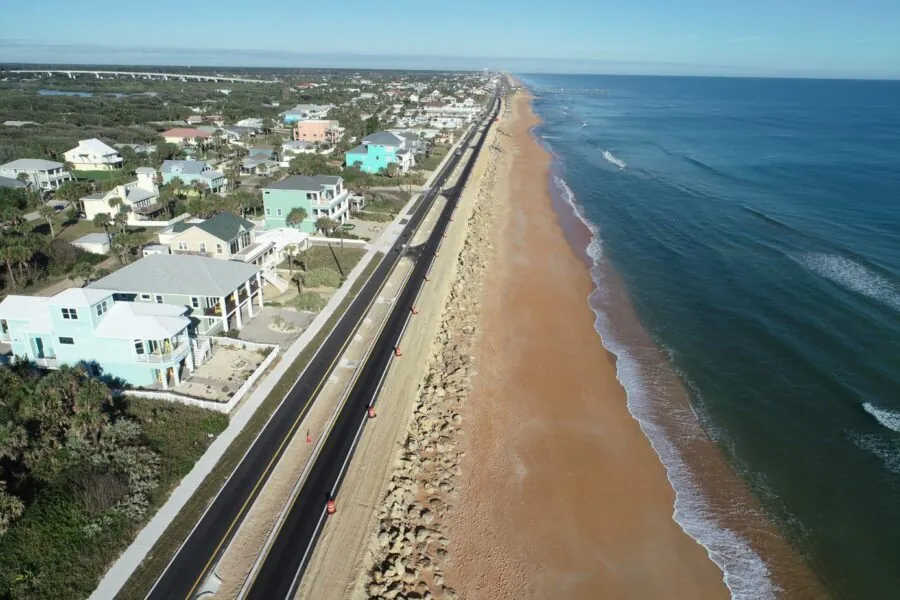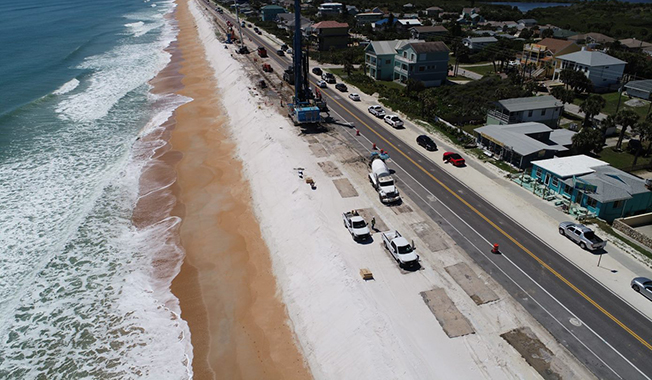RS&H-Designed SR A1A Project Brings More Resiliency to Flagler Beach

The 2020 Atlantic hurricane season has been one of the busiest on record, as storm names have raced through the alphabet as quickly as these tropical systems have formed. It has coastal areas from New Orleans to New York keeping an eye on weather forecasts and hoping their resiliency efforts are enough to hold off any storm.
In Florida, the home to the most direct hurricane hits in the U.S., lessons from prior storms have helped engineers design more resilient systems to help sustain the Sunshine State against the next “big one.”
Take Hurricane Matthew for example. The October 2016 hurricane spun up Florida’s east coast and triggered power outages for more than a million Floridians, caused nearly $1.5 billion in damage and took a big swing at infrastructure from the Florida Keys to Amelia Island.
In Flagler Beach, a town of about 5,000 between St. Augustine and Daytona Beach, wave after wave crashed into the narrow beach’s dunes and washed them away – along with a swath of State Road A1A. When the storm had moved on, the town’s main artery and evacuation route looked like it had been nibbled apart by a school of sharks.
After performing emergency repairs later that month in 2016, RS&H designers were tasked with engineering a more resilient, long-term solution for the 1.4-mile segment of A1A between South 22nd and South Ninth Streets, and a mile section between North 18th Street and just south of Osprey Drive. The resulting new roadway includes a curbed median, lanes sloping towards it to divert storm water to a French drain system for 25-year, 96-hour storms without positive discharge.
In addition to analysis and design, the project required review of access to properties adjacent to SR A1A in conjunction with the appropriate traffic control plan, provision for maintenance of pedestrian and bicycle traffic, restoration of signing and pavement markings, and permanent prohibition to parking along beach side of A1A in order to properly establish dune vegetation.
Righting What Went Wrong
When Hurricane Matthew struck the area, torrential rainfall had nowhere to go due to a lack of any sewer or drainage system in the road. As a result, heavy rainfall runoff from the storm washed out and undermined the revetment and roadway and threatened beach habitat.
“It was a double-whammy against the dunes,” said RS&H Project Manager Renato Gonzalez. “Rainfall water was also running over the top of the road further eroding the dunes. It was a disaster.”
The impact wasn’t only felt by residents. While the hurricane came at the end of the season, sea turtles have long made Flagler Beach a choice spot to lay their eggs between May and October. The erosion took away the sanctuary of the dunes, dunes that would have to be rebuilt with the same kind of sand that was washed out.
The Florida Department of Transportation (FDOT) engaged the services of RS&H to develop dune and roadway restoration, while Mott MacDonald helped identify and design the optimal context sensitive solution for protecting SR A1A. A major goal of the project apart from functionality and durability, was to preserve the character of the local environment.
Meanwhile, FDOT partnered with the Florida Department of Environmental Protection (DEP) to expedite review and process the environmental permit applications in a timely fashion to start and end construction with no significant impacts to turtle nesting season.
If the sand put back in place is too different from the sand that was there, it would interrupt the nesting patterns.
“The sand requirements were very specific,” said RS&H senior environmental scientist Chris Dailey, who led permitting for the project. “For instance, the sand can’t have any clay content whatsoever. There are two or three types of sand as far as FDOT is concerned, but the DEP uses more than 70 parameters for beach sand.”
Suitable sand was brought in from two local mines to help replenish the dunes that had eroded away.
A Resilient Solution
Aggressive design and construction schedules were established with permitting the needed seawall an important milestone. RS&H performed a seawall study in May 2018 that identified four viable wall concepts. After receiving feedback from the community, the team settled on a cantilevered secant pile wall based on cost, user impacts, constructability, and maintainability.
This secant wall is made up of a series of cast piles that overlap by 4 inches. The pylons were drilled down 36 feet, overlapped by 20-foot piles.
“This is the primary method of how seawalls are built in Europe,” Gonzalez said. “But it was a new way of doing things for Florida.”
But this seawall is hardly visible to passersby, as it is covered up by the replenished sand dunes. Inside, Glass fiber reinforced polymer (GRFP) rebar took the place of traditional steel. Apart from its corrosion-free properties, GFRP reinforcing had other advantages, including significant weight reduction compared to steel, which allowed for smaller equipment to handle the cages and reduce overall construction footprint.
“The buried secant-pile protection system provides one effective solution,” Gonzalez said. “When coupled with dune restoration, it provides a relatively low-impact solution for coastal dune highways.”
Plans were completed in July and bid by FDOT in August of 2018. With the contractor on board and the 2018 Atlantic hurricane season safely in the past, the secant pile subcontractor mobilized in February 2019, completing wall construction within five months.
“The advantage of the design is that we didn’t have to tear up and close the entire road, which was a community concern,” Gonzalez said.
Under the new roadway sits a new, giant stormwater system. Both sides of the road drain to the new median, which flumes water downward into inlets and then into a massive drainage pipe. Lanes were narrowed to 10 feet – with a 2-foot shoulder – to make space for the added median. The speed limit was also lowered from 45 to 25 mph to create safer crosswalks for pedestrians heading to the beach.
Storm-Ready
Sea turtles have again begun returning to Flagler Beach to nest and lay their eggs, just as the calendar turns to the beginning of hurricane season. Should another storm come soon, it will face a much more resilient dune and road facility.
“We really had to find a balance in the design to consider what the community was looking for, the needs of FDOT and the DEP,” Gonzalez said. “To find that sweet spot and to also complete design in less than a year, it was a big success for the entire team.”

